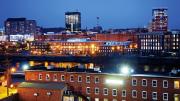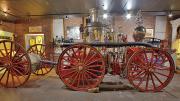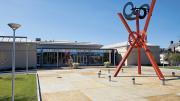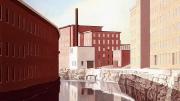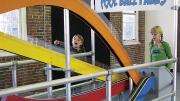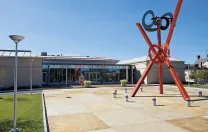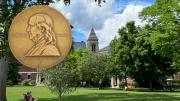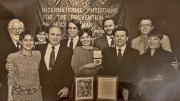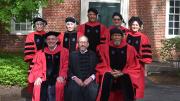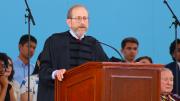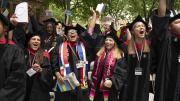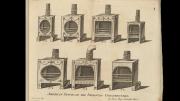Manchester, New Hampshire, in the 1980s was no kid’s paradise. “Growing up, we didn’t even come to this part of town,” says Chris Pappas ’02 while touring Elm Street, the city’s main drag. “The vacancy rate was tremendous and you really wouldn’t see any traffic or pedestrians.” The scene was even more ghostly a few blocks away by the Merrimack River, where most of the grand nineteenth-century brick factories that once filled 137 acres and comprised the largest cotton-textile plant in the country—the Amoskeag Manufacturing Company—sat empty, in various states of decay.
Much has changed in Manchester since then, and even since Pappas, now an elected member of the state’s Executive Council, returned to his hometown after graduation. For one, the “millyard” complex, still breathtakingly vast even at about half its peak size, now houses prime twenty-first-century businesses focused on technology, healthcare, and education (e.g., the University of New Hampshire and Southern New Hampshire University), along with restaurants, the Millyard Museum, and the SEE Science Center. UNH alone has more than 1,000 students in Manchester, Pappas says, and is expanding into the iconic Pandora Building.
Originally an Amoskeag property that dates to 1839 (its Gothic-style tower was added in 1879), the building is named for its former occupant, Pandora Industries Inc., which produced sweaters there from 1940 until the early 1980s. But then it too stood vacant for decades, with trees growing out of its roofs, until it was overhauled in 2012 by Dean Kamen, the inventor of the Segway and numerous medical devices. Kamen established DEKA Research and Development in one of the mills in 1982 and has been a consistent force in Manchester’s revitalization efforts, says Pappas. “Without his sinking millions of dollars into the Pandora, it would have been torn down.”
Like regional cities everywhere, Manchester has survived, and will continue to weather, dramatic swings in fortune, Pappas acknowledges. Issues such as crime, employment, and the quality of the schools will always warrant attention. But the “renaissance of the district,” he adds, coupled with projects like the new Manchester-Boston Regional Airport terminal and Verizon Wireless Arena, have helped spur economic development downtown.
Pappas has a stake in the city’s stability as part of the fourth-generation team that runs his family’s 98-year-old restaurant, The Puritan Backroom, a community gathering spot and frequent stop for presidential candidates. Yet he is also a force for growth and change. A proponent of the long-debated commuter railroad from Boston to southern New Hampshire, he influences statewide policies and finances as an Executive Councilor. (Viewed as a rising politician, he is considering a run for Congress in 2016.) There is “a great backbone of a young, creative class here,” he says, noting a rise in peers who recognize Manchester “as a good place to live and work,” many of whom are galvanizing civic engagement through the nonprofit Manchester Young Professionals Network.
Manchester, he points out, is also a great place to visit. The arena, restored Palace Theatre, and the Currier Museum of Art offer culture, while the Millyard Museum, America’s Credit Union Museum, and walking tours provide a fascinating look at New England’s industrial, architectural, and ethnic heritage. The SEE Science Center (also founded by Kamen) is a smaller version of Boston’s Children’s and Science museums—without the crowds.
The Currier Museum of Art, opened in 1929 andrenovated and expanded in 2006-2008, offers an intimate look at European and American paintings, sculpture, and furniture, along with a growing collection of modern and contemporary art. “One of the things I’ve been working on,” says Steve Konick, the Currier’s director of public relations and marketing, “is reminding Bostonians that we are less than an hour’s drive from Fenway. We have world-class art in a small city. That’s what makes us unique.” The winter exhibition, M.C. Escher: Reality and Illusion, drew nearly 30,000 people, while the current show, Still Life: 1970s Photorealism, on view through May 3, reflects how people and the built environment of that era actually looked. Works by Chuck Close, John Baeder, Audrey Flack, Tom Blackwell, and Duane Hanson are adjacent to museum-owned paintings by New Hampshire’s James Aponovich. A small side exhibit, Painterly to Precise: Richard Estes at the Currier, showcases two recent acquisitions: that artist’s Baby Doll Lounge (1978) and Qualicraft Shoes (The Chinese Lady) (1974). Throughout the year, the museum runs art classes, concerts, and monthly parties: “Signs of the Times,” inspired by the photorealism exhibit, is slated for April 2 (see www.currier.org/calendar for details). Also worth visiting is the Currier-owned Zimmerman House, the only Frank Lloyd Wright-designed building in New England open to the public. (Tours resume on April 16.)
The Millyard Museum, in a restored section of Mill #3, is run by the Manchester Historic Association. Exhibits explain the origins of this planned industrial city (hence the name change, from “Derryfield,” in 1810), the lives of its workers (using poignant oral histories), and the machinery that revolutionized textile production. In 1831, businessmen who had already built textile-manufacturing centers in Waltham and Lowell, Massachusetts, bought the few existing mills powered by the Amoskeag Falls on the Merrimack, water rights to the canal that bypassed the falls, and all of the property now considered downtown Manchester. “The Amoskeag Manufacturing Company literally designed the city, from laying out the streets and parks to building the factories and workers’ housing,” explains Jeffrey R. Barraclough, acting director of the historic association.
The company had a hand in most aspects of residents’ lives, too, even sponsoring athletic teams, fairs, plays, and concerts, he adds, keeping employees occupied and connected. Irish laborers built the mills, then worked in them; by the 1870s, they were joined by an influx of French-Canadians (who set up the nation’s first credit union, now a museum), and then immigrants from Germany, Lithuania, Russia, Poland, and Greece. (Still a resettlement city for modern refugees, Manchester’s high school reportedly has students speaking up to 60 different languages.)
At its peak, in 1915, the Amoskeag Manufacturing Company employed more than 17,000 workers, but was already ailing financially, Barraclough says. It closed in 1935, terminating thousands of workers in one day, and the Great New England Flood of 1936 wrecked “any last hopes of recovering from bankruptcy.”
Manchester rebounded, as would become its practice. City leaders prevented the factories from being sold at public auction and gutted, then drew new companies—but those, too, began to shut down or move out in the 1960s and 1970s. Among the last to go, in 1975, was the Chicopee Manufacturing Company. (Amoskeag, Life and Work in an American Factory, coauthored by Randolph Langenbach ’68, M.Arch. ’82, chronicles this event and other aspects of the life of the mills.)
Through the late 1960s and 1970s, work crews periodically razed mill structures and other historic city buildings, and filled in the two canals. Nevertheless, much remains. “One of the greatest accomplishments since this current revitalization started,” Barraclough adds, “is that many people in the city have developed a much greater respect for the past, for Manchester’s history.”
Pappas agrees. His Greek ancestors arrived at the turn of the twentieth century and, save for his time at Harvard, he himself has always lived within three miles of his childhood home. “I came back because I have a strong sense of place,” he adds, “and a commitment to see it thrive. In many ways I’ve rediscovered Manchester. I’ve had a lot of friends and family who have moved away to do other things, but those who have stayed are pleasantly surprised by the opportunities here and share in the pride that we are doing well.”
